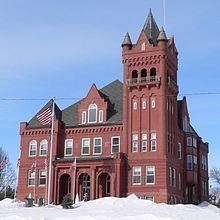Founded 1870 Population 9,411 (2013) University Wayne State College | Seat Wayne Website www.waynecountyne.org Area 1,147 km² Unemployment rate 1.9% (Apr 2015) | |
 | ||
Rivers South Logan Creek, Logan Creek, Humbug Creek | ||
Wayne County is a county in the U.S. state of Nebraska. As of the 2010 census, the population was 9,595. Its county seat is Wayne.
Contents
- Map of Wayne County NE USA
- History
- Geography
- Major highways
- Adjacent counties
- Demographics
- Communities
- Precincts
- References
Map of Wayne County, NE, USA
In the Nebraska license plate system, Wayne County is represented by the prefix 27 (it had the 27th-largest number of vehicles registered in the state when the license plate system was established in 1922).
History
Wayne County was organized by a proclamation of Governor David Butler in the fall of 1870. As the county was settled, precincts were formed and boundaries defined. Precincts were named for officials, early settlers, and neighborhood creeks. There are 13 precincts in Wayne County.
Wayne County, like the City of Wayne, was named for the Revolutionary War hero General Anthony Wayne.
Geography
According to the U.S. Census Bureau, the county has a total area of 443 square miles (1,150 km2), of which 443 square miles (1,150 km2) is land and 0.4 square miles (1.0 km2) (0.09%) is water.
Major highways
Adjacent counties
Demographics
As of the census of 2000, there were 9,851 people, 3,437 households, and 2,206 families residing in the county. The population density was 22 people per square mile (9/km²). There were 3,662 housing units at an average density of 8 per square mile (3/km²). The racial makeup of the county was 96.78% White, 0.94% Black or African American, 0.35% Native American, 0.35% Asian, 0.01% Pacific Islander, 0.85% from other races, and 0.72% from two or more races. 1.48% of the population were Hispanic or Latino of any race. 57.5% were of German, 6.0% Irish and 5.9% Swedish ancestry according to Census 2000.
There were 3,437 households out of which 30.50% had children under the age of 18 living with them, 56.20% were married couples living together, 5.40% had a female householder with no husband present, and 35.80% were non-families. 25.10% of all households were made up of individuals and 10.60% had someone living alone who was 65 years of age or older. The average household size was 2.51 and the average family size was 3.02.
In the county, the population was spread out with 21.60% under the age of 18, 25.40% from 18 to 24, 21.20% from 25 to 44, 18.00% from 45 to 64, and 13.70% who were 65 years of age or older. The median age was 28 years. For every 100 females there were 92.30 males. For every 100 females age 18 and over, there were 92.30 males.
The median income for a household in the county was $32,366, and the median income for a family was $43,840. Males had a median income of $27,848 versus $20,376 for females. The per capita income for the county was $14,644. About 7.40% of families and 14.50% of the population were below the poverty line, including 10.60% of those under age 18 and 7.20% of those age 65 or over.
Communities
Several towns in Wayne County's early history no longer exist. LaPorte had nearly 300 citizens at one time and was home to a temporary courthouse until the railroad chose a different route. Towns such as Taffe, Logan City, Apex, Melvin, Weber and Spring Branch no longer exist.
Precincts
There are currently 13 precincts in Wayne County. They were named for officials, early settlers or neighborhood creeks.
